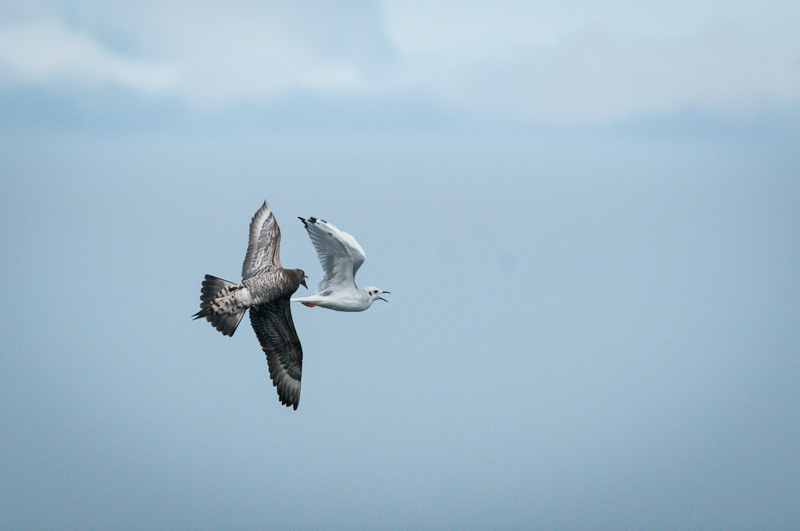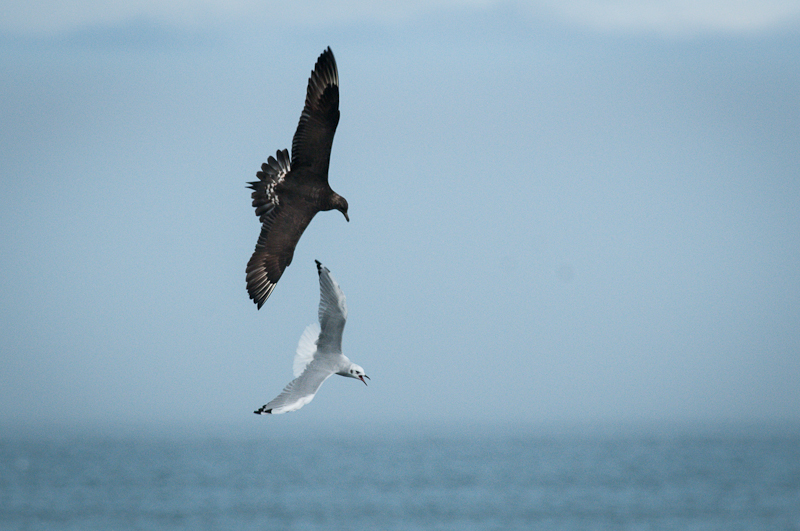Aug. 28th - Sept. 5th
First RED PHALAROPE of the season
PARASITIC JAEGERS
POMARINE JAEGERS
2 WHIMBREL
BROADWING HAWK
PEREGRINE FALCON
SHARP-SHINNED HAWK
NORTHERN HARRIER
MERLIN
AMERICAN KESTREL
RED-THROATED LOON
MANX SHEARWATER
Red-necked phalaropes
Semipalmated sandpipers
Least sandpipers
Spotted sandpiper
Double crested cormorant
Great cormorant
Sooty shearwater
Great shearwater
Common murre
Black guillemot
Razorbill
2 Ruby-throated hummingbirds
Northern Gannet
Common eider
Great blue heron
Bald eagle
Arctic tern
Bonaparte’s gull
Black legged kittiwake
Osprey
Belted kingfisher
American goldfinch
Bird activity has shifted from the offshore to the inshore, with large groups of gulls, alcids and shearwaters feeding just off of Popes and Casco Bay island. These groups consist mainly of herring, black-backed, and bonaparte's gulls, kittiwakes and arctic terns. When the tide is running strong, these groups can easily number in the thousands of birds spread out over a relatively small area as they feed on small herring. Within these groups are the occasional POMARINE and PARASITIC jaeger. I am sure that these groups contain some rarer gull species but havn't had a whole lot of time to check. Groups of Red-necked phalaropes are also quite numerous in this area.
We have been spending most of our time off Black's harbour with feeding fin and humpback whales. Bird activity in this area has decreased in the last few days but small numbers of MANX, sooty and great shearwaters are still around, along with the occasional puffin and small numbers of gannets. The jaegers are always exciting to watch as they chase after the other birds.
 |
| Parasitic jaeger pursuing a tern |
 |
| Parasitic jaeger |
The BALD EAGLES have also been incredible as they join in to feed on the
herring and mackerel schools around the islands. I counted over 15 eagles on a single
rock near Green's island.
 |
| Bald eagles |
Plenty of small groups of migrant shorebirds, mostly least and semipalmated sandpipers with some groups of larger birds that I am unable to identify at a distance. On Aug. 28th there were two WHIMBRELS that flew over the boat as it was tied up at the wharf in St. Andrews.
On Sept. 1st we had two female ruby-throated hummingbirds. One of these birds flew right up to a passenger sporting a bright red coat and inspected it closely before flying off again.
Sept. 1st was also a good day for migrant raptors. On our way through Little Letete passage at 2:20PM there were three raptors soaring in a thermal above Mac's island. Closer inspection revealed a BROAD-WING HAWK and a SHARP-SHINNED HAWK. I was not able to identifiy the remaining bird. On the next pass through the channel at 4:40PM, there was a NORTHERN HARRIER.
 |
| Hawks over Mac's island. Broadwing hawk (top right) Sharp-shinned hawk (bottom left) |
While were on the subject of raptors...I also had an AMERICAN KESTREL over White island on the 1st, a MERLIN in the same area on the 2nd, and a very handsome adult PEREGRINE FALCON perched atop the power tower on Mac's island on Sept. 4th.
 |
| Merlin |
 |
| Peregrine falcon perched on power tower on Mac's island |
On Sept. 2nd I had my first of season RED-PHALAROPE with a group of red-necked phalaropes as well as a RED-THROATED LOON
While Captain Mat was on vacation, he spotted a WILSON"S SNIPE in Bar harbour, ME. Good job Mat!
 |
| Wilson's snipe. Sighted and photographed by Mathias Rudi in Bar Harbour, ME |
Quoddy Link will be offering a pelagic/coastal bird tour at the end of September. The focus of this tour will be the birds of the West isles and the Wolves. This is a great opportunity to work on identification of gulls, terns, alcids and shearwaters as well as other pelagic species. The cost will be 50$ per person plus tax. There will be a lot of experienced birders aboard to help out and I am really looking forward to it. The tentative date is set for the 30th of September, departing at 8AM from the St. Andrews wharf. If you are interested, please e-mail me at nickjameshawkins@gmail.com and I will be sure that you receive this e-mail. If you can not attend on the 30th, but would still be interested let me know. If there is enough interest we will do a second tour at the start of October.
Cheers!
-Nick
























































